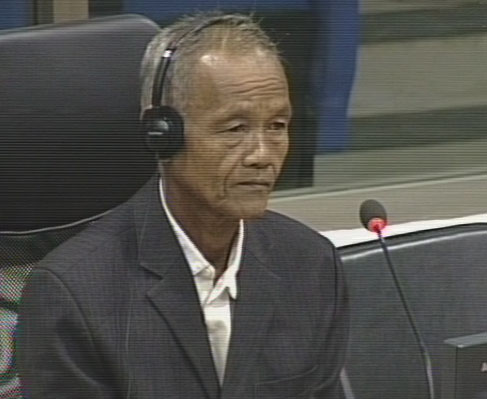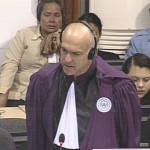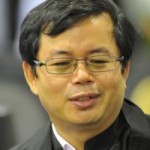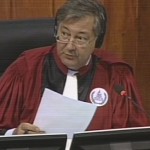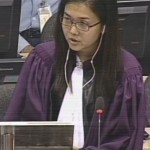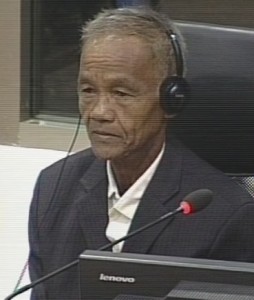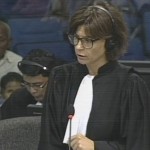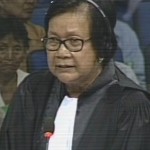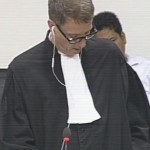“Hun Sen Got His Eye Impairment While He Was With Me” — Witness testified
Today, on June 22, the court continued to hear the testimony of witness Saem Hoeung (or Hun) alias Kim that had started last Wednesday, when the court was last in session.
The International Co-Prosecutor, Nicholas Koumjian, admitted that he had made a mistake with the Year of the Horse (the only reference that Mr. Hoeung recalled about his birth year) and confirmed that, if he had been born on November of the Year of the Horse, this year would have been 1954 – not 1953. If it was 1954, this would have made Mr. Hoeung 15 years old at the time of the Lon Nol ouster in 1970 and 20 years old when the Khmer Rouge took power in 1975. Mr. Hoeung insisted he was around 17 years old when he joined.
Mr. Hoeung said that he joined the revolution because the King called on Cambodians to liberate him and the country.
He was a soldier in Division 310, Regiment 12, Battalion 123, Company 5.
His biography taken by the Khmer Rouge, dated the 24th of August of 1976, when he was arrested, was read aloud: “The reason that Angkar removed from my unit and sent me to the unfavorable element unit was because I traveled around arbitrarily and didn’t obey the disciplines [of the party]… however I have made every effort to change and remove all elements that are unfavorable.”
Mr. Hoeung explained that even a solider like himself, who had been in the front lines leading up to the “liberation” of Phnom Penh, was “severely mistreated.” He said he didn’t get enough food or freedom of speech. He said the reason they accused him was that “sometimes I moved to chit-chat with members of another unit and I was accused of being too liberal with my movements… I didn’t like the DK regime.“
The prosecutor asked him why he didn’t like the DK regime.
Mr. Hoeung explained:
“I joined voluntarily but after I made my own observations… it was contradictory to my hope and expectations…they mistreated soldiers, they mistreated their own people and for that I disliked the Khmer Rouge… “
Prison without walls
Mr . Koumjian then read from a DC-Cam interview where Mr. Hoeung had said:
“I never forgot about the Pol Pot regime.. and I told my children that they have to be against the regime and prevent it again from happening in Cambodia. All of us lived in a prison without walls.”
Mr. Hoeung then explained what he had meant by a prison without walls. He said he had spoken to other soldiers that were working nearby and they spoke about the limits on their movements and how this made them feel as if they “lived in a prison without walls.” That was “totally contradictory to when we were fighting on the battlefield,” he added.
Disarmed
Mr. Hoeung confirmed that after he was “screened,” (presumably on or around the 24th of August of 1976 when they wrote down his biography) they took away his weapons. He said they told him the purpose of the army had changed and that they now had to engage in the building of the country. “Every soldier in my unit was disarmed,” he said. He himself remained without a weapon for the rest of the DK period.
North Zone purges
Mr. Hoeung recalled that his whole division (#310 from the North Zone) was called into a meeting at Wat Phnom. and cadres from the South West Zone replaced his superiors and told them that their leaders had betrayed the revolution. They were asked if they wanted to heard the recording of our superior and then they played the confession of Ta Oeun (head of division 310).
Mr. Hoeung said he didn’t understand the content of the confession because there were many people and the voice was not clear.
Torture-tainted evidence
Mr. Hoeung was asked if he knew that Oeun had been sent to S-21 (also known as Tuol Sleng). He confirmed that he knew that Oeun had been sent to Tuol Sleng.
Mr. Kong Sam Onn, Co-Lawyer for Khieu Samphan, rose in objection to the former question but said that it was already too late because the witness had been allowed to answer a leading question.
Mr. Koumjian responded that it was clearly established that Ta Oeun had arrived at S-21 on the 17 of February of 1977 and that his confession is dated on 20th of February. He then attempted to read from the confession of Song which had been arrested with Ta Oeun.
Judge Lavergne interrupted to point out that Mr. Koumjian had read the content of a confession that may have been obtained by torture, and thus it might be inadmissible. “I would suggest ,” Judge Lavergne said “that for the time being it would be best if you move on to another line of questioning.”
Mr. Koumjian agreed to move on but stated, for the record, and consistent with his position, that the prosecution believes that there is information in these confession such as the dates and places that they were arrested that should be allowed to be used. “In order to avoid controversy at this time,” Mr. Koumjian said, I will move on.“
Torture and Security Office
Mr. Hoeung was asked whether he had witnessed any torture during the DK period. He went back and forth in his testimony.
He said:
“I witnessed [the torture] and I would like to have justice for the victims. When I was at Wat Phnom there was security office and people were tortured. I did not enter the security office but male and female people and children were tortured.”
He then added that he had heard the screams of those detainees but that he didn’t witness the incident. He clarified that the security office was north of Wat Phnom, opposite Calmette Hospital.
He said the security office was a house that was now surrounded by corrugated iron and no one could peep into it, but “for his case” he could peep in “by looking through a hole in his house.” He said he “peeped-in” every morning. Later he would say that he could “see the security officer from a far distance.”
At some point, Mr. Hoeung said again: “I heard the screaming and I secretly looked into the security office. I witnessed the torture at that place and I heard the sound of beatings every morning. I heard the sounds of children crying.”
Kampong Chhnang Airfield Worksite (KC)
Mr. Koumjian then gave the floor to his national colleague, Ms. Song Chorvoin Deputy Co-Prosecutor. She asked about his time at the Kampong Chhnang Airfield Worksite (KC). Mr. Hoeung later clarified that he spent one year at the worksite.
Mr. Hoeung was sent to the KC in early 1977 before the Khmer New Year. His OCIJ statement said that when he first arrived he saw ”hundreds of male and female solider who had been accused of being affiliated with the traitorous network.”
Mr. Hoeung said that when he first arrived only 2 % of the construction had been built and he was first assigned, by Cham, his immediate supervisor, to first clear the land with a tractor and then to pick up logs and uproot trees.
Ms. Chorvoin read from his OCIJ statement:
“The work was very difficult and we were under constant watch as we had been linked to the traitorous network.. and if we broke the earth-carrying basket or our hoes we would be arrested and we could be accused of being enemies.”
“Who kept an eye on you?” She asked.
“It was the unit chief that kept eye on us… if the we broke the earth-carrying basket or hoes, we would be accused of betraying the revolution..”
Those at KC who fell sick would be put under surveillance and they did not receive sufficient to eat, he said. If they felt sick, he added, the food ration would be reduced to half of the bowl. “So the work there was really difficult, he said, “we had limited food rations, and we were told to wake up at 5:30.”
Mr. Hoeung confirmed that the unit chief did not join in the work. “He was there to see if some workers were inactive or sitting too long,” he added.
No longer soldiers
Mr. Hoeung said that he believed there were tens of thousands of them and that they were all soldiers. “They were not ordinary civilians…even the women were female soldiers, ” he said.
He said, though, that the “soldiers did not longer hold any position” at the worksite. “They were considered normal civilians, working as normal,” he said, “they were no longer considered soldiers.”
Arrests – light and serious offenses
Mr. Hoeung said that he believed that all of the workers at the KC worksite were prisoners. “They were all considered bad elements… and they were forced to engage in risky work like crushing rocks. Sometimes they would be crushed by the rocks. In a way, they were being tortured through this form of hard work.”
Mr. Hoeung said that the light offenders were subject to normal work with little food.
The serious offenders – like breaking hoes or the earth-carrying baskets, or walking freely – Mr. Hoeung said, would be sent away. They would be sent to the Angka office.
“What do you mean by Ankga office?” Ms. Chorvoin asked.
“They were sent there to be hanged, they were sent to be killed, and that’s the end of it,” Mr. Hoeung said.
He later said that 12 people from his unit disappeared which included two persons from his group named Pi and Sun. Mr. Hoeung had worked together with Pi and Sun for about a month and a half.
“Pi and Sun were arrested for stealing tobacco leaves,” he said, “I witnessed their arrest. I saw them tie their hands behind the back. I don’t know where they were taken.”
He then explained that Pi and Sun planted tobacco tress. Then some leaves fell, they cut them in to small pieces, and smoked them. They were called into a meeting and they were told they were enemies.
When PI was arrested and being led away, Mr. Hoeung recalled that Pi told him: “I am now arrested, and I will be killed. Tell my family that I was taken away and killed.”
“I do not know where they took him to,” Mr. Hoeung said, “to my knowledge they did not commit any mistake… the only mistake was to pick tobacco leaves . . . from the day of the arrest they disappeared and I have never seen them again.”
Killing Site next to the Airport
Mr. Hoeung said that killings did occur next to the KC airfield. He said people were killed west of the airfield. There was no village there, he explained but it was in Baribour District.
He said that it was not far from the airport, about 500 meters to 1 kilometer away from the worksite.
He said that he knew it was a killing site because the people who were arrested sent there. He then said that he had concluded that because they were prohibited from going to that place because that is where the killing happened and they “didn’t want us to see it.”
“How were they killed? Ms. Chorvoin asked.
“They would use the hoes to hit the back of their necks.,” Mr. Hoeung said “of course they would not use bullets as the sound of bullets would have been heard by us at the worksite.”
Visit of Khieu Samphan
Ms. Chorvoin then read from Mr. Hoeung ’s OCIJ interview where he states that by late 1977 the runways at the KC airfield were ready and that he saw Khieu Samphan coming to visit in a helicopter. At around 10 a.m. he came with Chinese visitors and you [Mr. Hoeung ] were standing about 50 metes away from where he was.” Ms. Chorvoin said.
Mr. Hoeung explained that he only saw him that one time. “I saw a helicopter land and we were told that that was Khieu Samphan,” Mr. Hoeung said, “I could not tell you anything else.”
Ms. Marie Guiraud, International Civil Party Lead Co-Lawyer, would later delve more into how he had recognized Khieu Samphan.
Mr. Hoeung explained to Ms. Guiraud, that he had seen Khieu Samphan and Ieng Sary in their car when his unit was assigned to protect their convoy, while he was stationed in Phnom Penh. “I saw them with my own eyes, he said.”
Mr. Hoeung said that he had seen them in Wat Phnom near the central market.
“When the convoy vehicles approached I saw them,” Mr. Hoeung continued “I was at a distance and now when I see him in the court he looks much older than the last time I saw him in Phnom Penh. My colleagues [then] told me that that person was Ieng Saray and that person was Khieu Samphan.”
Ta Lvey and Sou Met
Ms. Chet Vanly, Civil Party Co-Lawyer, asked Mr. Hoeung about Ta Lvey and Sou Met who were the heads of the KC airfield. Mr. Hoeung said that he had heard the names but had never met them personally.
Ms. Vanly asked: “you said you were sent to the KC airfield for re-fashioning or re-education. What do you mean by re-fashioning or re-education? Were you there as prisoner?”
“I was a prisoner among all others. I was relocated to that place for tempering. We were there to correct ourselves. And if were able to correct ourselves we would be OK. If we could not correct ourselves we would remain as prisoner for ever.”
“Did you face difficulties at the work?” Ms. Vanly asked.
“I was relocated to work at that airfield. I did not have enough to eat.. I did not have any sleep…I faced many difficulties while I was working there.“
Defense: Cross-Examination
Mr. Koppe, defense counsel for Nuon Chea, starts by asking Mr. Hoeung whether, as he stated to the DC-Cam interviewer, he had been chief of battalion 307 at one point of time.
Mr. Hoeung clarifies that it was a provisional appointment and that he commanded three companies of 130 soldiers each for a total of 390 combatants. He said that he wasn’t appointed permanently because of his relation to the traitorous network or his “bad tendencies.”
Mr. Koppe also clarifies that when Mr. Hoeung wrote his biography of the 24th of August in 1976, he was part of Division 310, Regiment 12, Battalion 123, and Company 5.
Mr. Koppe confirms that Mr. Hoeung remembers the Regiment 12 commander Peng. Mr. Hoeung says he knows him rather well and that Peng was four levels up the chain of command. “Below him there was the Battalion, then the Company, and then the Platoon which was my level,” Mr. Hoeung said.
Hun Sen
Mr. Hoeung then affirmed that the current prime minister of Cambodia was the deputy division chief of Division 310.
Mr. Koppe read from his DC-Cam interview where Mr. Hoeung had stated that Hun Sen had a military position in 310, however that he was not sure whether he was a commander or a deputy commander.
The DC-Cam interviewer then asks him how did he know that it was Hun Sen:
“I remained in Division 310, I was promoted to the Battalion level… and Hun Sen was the division deputy chief… I know him clearly. He has an eye impairment from a battlefield where he fought with me in a battlefield… in the north of Phnom Penh…”
Yes he got this [eye impairment] while he was with me… he was hit by a small fragment of an M-70 grenade.”
Mr. Koppe asks him if it this statement that he gave to DC-Cam is correct.
Mr. Hoeung says that yes this is correct.
Mr. Koppe says he’s puzzled because he though they had just established before that Vun was the deputy chief of Division 310.
Mr. Hoeung insists that it was Hun Sen who was the deputy chief.
“But wasn’t Hun Sen in the East Zone Division?”
“At that time I did not know his actual background, whether he came form the north or the east zone, but I saw him in the division 310 in the north zone.. that’s all I know about him,” Mr. Hoeung said.
Plot to overthrow the regime
Mr. Koppe reads from DC-Cam’s statements where Mr. Hoeung explains that Ta Oeun (head of division 310) did have a plot to overthrow the Khmer Rouge.
“He [Ta Oeun] tried to build up internal forces called the Khmer White to struggle under the Khmer Rouge… he sent me to penetrate myself in Kampong Chang and he gave me a platoon to lead and 6 CSM trucks to transport weapons.”
Mr. Hoeung confirms that he did transport weapons in six 10-wheeler CSM trucks, all full of weapons like M-79s and AK rifles, to the East Zone and gave them to Tol of the Sector Committee. The plan according to Mr. Hoeung was to attack and seize the Pochentong Airport, a weapons repository, and a radio station.
Mr. Hoeung said that he completed the transfer and one month later (in mid 1977) the plan was leaked and Ta Oeun was arrested. He confirms that he led 36 men in his platoon.
Mr. Hoeung also said that it was a combined attack with the East Zone forces.
“The east zone would be engaged in its own zone, and the north zone would be responsible for its own,” Mr. Hoeung said, “we had to liberate ourselves form the regime.. so we needed to attack and defeat [it].“
Mr. Hoeung then said that in order to survive he changed his biography to say he was from Siem Reap and not from Baksna vilalge, in Baray District in Kampong Thom Province.
Meeting
Mr. Hoeung also said that he went to a meeting where Ta Oeun had spoken about the plot to overthrow the Khmer Rouge. He said the meeting occurred to the south of the hospital of Precah Ket Mealea hospital. The meeting was attended by all members of the regiment and the battalion in division 301. Mr. Hoeung estimated that to be around 500 men. Hun Sen, according to Hoeung, did not participate in the meeting.
_
The court adjourned and will finish hearing the cross-examination of witness Mr. Hoeung tomorrow at 9 a.m.

